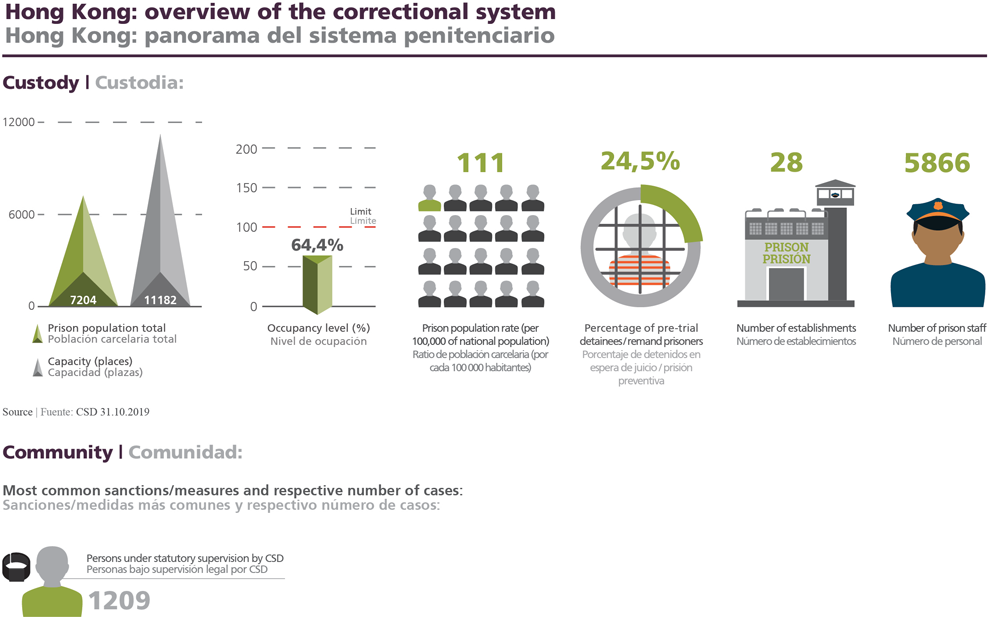// Interview: Woo Ying-ming
Commissioner of Correctional Services, Hong Kong
JT: Although the prison population rate of Hong Kong has declined significantly over the last decade, it remains relatively high, at around 110 prisoners per 100,000 of regional population. What do you consider necessary to do in order to decrease the prison population rate and what role can the Correctional Services play in a reform endeavour in that sense?
WYM: The imprisonment rate in Hong Kong has been declining over the past decade, i.e. from around 148 persons in custody (PICs) per 100,000 of regional population in 2009 to 111 PICs per 100,000 of regional population in 2018.
Over the years, we have been striving to provide a secure, safe, humane, decent and healthy custodial environment for PICs and help offenders rehabilitate and reintegrate into society as law-abiding citizens. To ensure the sustainable development of correctional work, the Correctional Services Department (CSD) has formulated the Strategic Plan in 2018, of which the following seven key strategic objectives are emphasised:
- Building a sustainable correctional system with integrated operational protocol
- Strengthening the secure and humane management of persons in custody
- Addressing diverse needs of persons in custody and reducing recidivism
- Reaching out to diverse populations to enhance the synergy between CSD and community stakeholders for service delivery
- Shaping workplace culture and increasing workforce capability
- Enhancing partnerships and networks with other correctional authorities
- Broadening and deepening research capacity
Although dedicated custodial work has laid a solid foundation for offender rehabilitation, that alone is insufficient to change them from head to toe. Therefore, the CSD has devised a diversified and through-care rehabilitation package, including Risks and Needs Assessment and Management Protocol (RNAMP)[1], welfare support and counselling services, psychological services, up-to-date education programmes, market-oriented vocational training and statutory supervision, to cater for rehabilitative needs of PICs from their admission into correctional institutions to their reintegration into society.
We have also been developing closer partnerships with various community stakeholders, such as all the District Fight Crime Committees of Hong Kong, renowned charitable organisations, non-government organisations (NGOs), the business and academic sectors, etc. Rehabilitated persons (i.e. PICs after discharge) will be referred to appropriate government departments or NGOs for assistance according to their needs and wishes under the Continuing Care Project. We also collaborate with social enterprises on the training and referral of suitable rehabilitated offenders to relevant industries. Moreover, the CSD has taken the initiative to invite different stakeholders, such as government officials, Legislative Council members, social leaders, athletes and artists to visit our institutions in order to enhance their understanding of our services and gain their support for offender rehabilitation.
For young people in particular, the CSD proactively launches community education through the Rehabilitation Pioneer Project (RPP). The messages of leading a law-abiding and drug-free life as well as supporting offender rehabilitation are disseminated to youngsters through the launching of ten different initiatives under RPP, such as the Reflective Path, Green Haven Scheme, Student Forum, Creation and Rehabilitation, and Rehabilitation Pioneer Leaders. So far, the RPP has been well received with positive responses. In the past year alone, a total of about 560 activities were organised under RPP and nearly 50,000 participants engaged in the activities. The extension of our service scope to cover community education not only helps to encourage youngsters to be pillars of society in the future, but also reduces their chances of going astray.
The recidivism rate (measuring the reconviction of rehabilitated PICs within 2 years after their discharge) has significantly decreased from 39.9% to 24.8% between 2000 and 2016.
To meet the changing needs over time and the rising expectations of the public, the CSD will continue to provide insightful and innovative inputs to formulate more diversified rehabilitation programmes and community education initiatives, as well as mobilise social resources from different stakeholders to form a “partnership” and “synergy” for closer collaboration between the CSD and the community.
Therefore, the CSD has devised a diversified and through-care rehabilitation package, including Risks and Needs Assessment and Management Protocol (RNAMP) , welfare support and counselling services, psychological services, up-to-date education programmes, market-oriented vocational training and statutory supervision, to cater for rehabilitative needs of PICs from their admission into correctional institutions to their reintegration into society.
JT: Statistical data shows that Hong Kong’s prison population includes 25% of pre-trial detainees or remand prisoners and almost 30% of foreign nationals. What challenges do these specific groups pose to the prison system and how does the Correctional Services Department meet their special characteristics and needs?
WYM: To be more accurate, PICs on remand and of other nationalities constitute around 24% and 20% respectively of the overall penal population according to the statistics as at November 2019.
The CSD has a dedicated professional team focusing on specific aspects to deal with the potential risks and needs of remand PICs. For instance, we have established a comprehensive health screening and medical care mechanism which is managed by medical officers seconded from the Department of Health and disciplined staff with nursing qualifications to provide round-the-clock medical care and monitoring of physical and mental health conditions of PICs. In addition, on-site clinical psychologists also provide timely intervention to PICs’ adjustment and emotional problems.
For PICs of other nationalities, the language barrier and cultural difference are the main causes of their misunderstanding of the penal management and treatment. The CSD has formulated policies and procedures as well as engaged relevant stakeholders to proactively address the concerns of the PICs of other nationalities. We have published an information booklet in 27 languages for guidance to all newly admitted PICs. The publication assists different ethnicities to better understand custodial treatment and requirements, such as the requirement for conduct and discipline, the means for keeping in touch with the outside world, health and wellbeing, and channels of complaints.
To resolve the language barrier, apart from the provision of qualified interpretation services, tablet computers with the tools to instantly translate multiple languages (currently 62 languages/dialects) have been introduced into all correctional facilities. The CSD has also devised a human resources strategy for the recruitment of staff with other ethnic backgrounds.
Recognising the need for PICs of other nationalities to communicate with their families and friends including those overseas, they are well equipped with all possible communication channels including mail, phone calls and visits, etc.
The CSD has been working closely with different Consular Offices as well as religious groups. There is an opportunity to easily visit and provide support to PICs. Their observations and views are always weighted and taken into account in the policy making by the penal management departments. We have got involved with different NGOs and volunteer groups to provide those PICs with a variety of services, including hobby classes on local languages, cultural and physical activities, festive events of different nations, etc.
JT: Proportionally, Hong Kong has the highest female prison population in the world at 20.8% of the total prison population; the majority of female prisoners are foreign nationals sentenced for drug-related offences (as drug ‘mules’) or immigration violations. What are the main differences and special care that the female prison population requires in the Hong Kong prison context and how does the Correctional Department help female persons in custody to turn over a new leaf in an innovative way?
WYM: The CSD is committed to providing fair and comprehensive treatment to all PICs. Compared with male counterparts, female PICs are more likely to have emotional disorders, prior trauma and abuse experiences, and self-harm tendencies. They also tend to have additional needs arising from family responsibility. To address the specific needs of female PICs, innovative and appropriate rehabilitation programmes based on research findings have been devised. For example, Psy Gym was established at Lo Wu Correctional Institution (LWCI) to provide treatment programmes incorporating positive psychology intervention, and art therapy for female PICs who have been assessed as having a high risk of reoffending or being in need of treatment for their developmental and emotional issues.
Since family support is crucial to the rehabilitation of female PICs, initiatives to promote a family-driven rehabilitative approach have been rolled out. For example, incarcerated mothers are encouraged to fulfil their family role by spending time with their young children at a specifically designated “Parent-Child Centre”, which is a well-equipped playroom with ample parental care resources for their visits.
The CSD has launched the “Rehabilitation Family Programme” (RFP). Through various activities, talks and sharing sessions, the RFP helps PICs improve communication and rebuild relationships with their families, which in turn bolsters their determination to start anew. One of the latest initiatives for fostering interaction between female PICs and their children is the Storytelling Programme launched at LWCI. Through this training programme, female PICs not only learnt storytelling skills for developing intimacy with their children, but also took part in the production of four audio story books with their voices.
Furthermore, female PICs are provided with opportunities in education and vocational training that are different from those of their male counterparts. To recognise the PICs’ efforts and reinforce their personal enhancement, the CSD has held certificate presentation ceremonies which provide the platform for female PICs to share their academic achievements and spend time with their families.
On vocational training, female PICs are encouraged to participate in tailor-made training courses in areas with high demands of female labour, such as Nail Care, Hair and Beauty Styling, Retail and Commercial Services, Food and Beverage Services and Pet Grooming, etc. There is a new learning mode of virtual reality technology, “Virtual Reality Merchandising and Retail Management Course” with a view to equipping them with more technology-based knowledge.
To address the rehabilitation needs of female drug abusers, the CSD has introduced “mindfulness” to drug addiction treatment programmes. In 2017, the “Mindfulness Corner” with well-equipped facilities started operation at Nei Kwu Correctional Institution (NKCI), in which mindfulness practice was employed to help female drug abusers ameliorate their addiction.
For female PICs of other nationalities, apart from other general initiatives, we have also invited NGOs and volunteers such as the CSD Rehabilitation Volunteer Group to organise hobby classes for non-Chinese-speaking PICs on a regular basis.
With a view to strengthening family support for female PICs of other nationalities, the introduction of innovative technologies such as the Integrated Intelligence Communication System and PIC self-service kiosks under the Smart Prison Protocol would overcome the existing constraints and greatly facilitate them having better communication with their families and friends including those overseas.
JT: Could you please tell us about the rehabilitation process of people who are under custody of HK Correctional Services and how the Correctional Services Department maximises rehabilitation opportunities for persons in custody in terms of education programmes and vocational training?
WYM: The CSD provides half-day compulsory formal education for young offenders under the age of 21. The courses are conducted by qualified teachers. It also allows young PICs to sit the Hong Kong Diploma of Secondary Education (HKDSE) Examination so that they can obtain the necessary qualifications for further studies or employment after release.
I believe interest leads young people to learn better. Apart from mainstream study, we have launched STEM education programmes for young PICs to help them gain integrated knowledge in the areas of “Science”, “Technology”, “Engineering” and “Mathematics” (STEM) in an interesting and interactive way. Such programmes can also cultivate their innovative thinking and problem-solving skills which are necessary in a rapidly changing society. At present, several STEM courses are provided, such as “Intelligent Humanoid Robot Programming”, “Paper Bridge Building” and “3D Mapping”.
The CSD also encourages adult PICs to pursue further studies in their spare time on a voluntary basis and enrol in university distance learning courses according to their interests and abilities. In the past five years, a total of 29 PICs were awarded 26 bachelor’s degrees and five master’s degrees through distance learning. The CSD has set up a number of education fund and subsidiary schemes to provide financial aid for PICs to pursue further studies. Funding is obtained by donations from charitable organisations and the community.
Exploring and providing market-oriented vocational training programmes runs parallel in importance under the strategic focus of addressing diverse needs of PICs and reducing reoffending. Having taken into account the situation of the local employment market, the CSD has been collaborating with various accredited training bodies, such as the Employees Retraining Board, the Construction Industry Council, and the Vocational Training Council, to provide eligible PICs with more than 40 full-time and part-time vocational training courses. These courses cover a wide range of industries, such as construction, business, food and beverages, retail, beauty care, transport, logistics, laundry services, computer applications and environmental services.
In 2019, the CSD made a breakthrough by using virtual reality technology in vocational training courses. The first course, “Virtual Reality Welding Course”, was kicked off in the maximum-security institution. We believe that the application of new technology in vocational training not only enhances PICs’ knowledge in technology and facilitates their learning in an innovative way, but also addresses security concerns when organising more vocational training courses in penal settings.
I believe interest leads young people to learn better. Apart from mainstream study, we have launched STEM education programmes for young PICs to help them gain integrated knowledge in the areas of “Science”, “Technology”, “Engineering” and “Mathematics” (STEM) in an interesting and interactive way. Such programmes can also cultivate their innovative thinking and problem-solving skills which are necessary in a rapidly changing society.
JT: News reports dating back to 2017 state that there was no internet access for prisoners in the Hong Kong correctional system. However, in 2019, news reports speak of a technological revolution that not only brings high-level technology to the management and surveillance of correctional institutions and prisoners (the so-called ‘Smart Prisons’), but also electronic communication devices, such as tablets, for prisoners. What is this technological plan, how has the implementation of technologies evolved in correctional services, and to what extent do they fulfil the Department’s goals and influence the quality of life of prisoners themselves?
WYM: As mentioned, in 2018 the CSD formulated the “Strategic Plan” which included the “integrated operational protocol through the development of Smart Prison” in order to modernise, informatise and humanise our management mode.
The “Smart Prison” concept comprises four key elements, namely “Development of Smart Governance”, “Implementation of Process Innovation”, “Cultivating Knowledge-based Correctional Officers and Enhancing the Capacities of Rehabilitated Persons to Re-integrate into Society”, and “Application of Smart Prison Designs”. Many trial projects have already been introduced to designated locations of correctional facilities. All those ongoing or planned technological trials can be generally categorised into the following: (i) Security and Monitoring System; (ii) Operation and Management System; (iii) PIC Self-Management System and (iv) Staff Capacity Enhancement System. By implementing the above, we aim to enhance the efficiency of custodial management, the security level of institutions, and the effectiveness of rehabilitation programmes provided for PICs.
In the long run, “Smart Prison” can help the authority to systematically collect useful data for our planning and administration purposes. We believe that the subsequent big data analysis could strengthen our ability to develop an appropriate policy for enhancing the operational efficiency of penal management, strengthen staff readiness in emergency situations, enhance the effectiveness of rehabilitation programmes and PICs’ self-management capability, improve the working environment for the recruitment and retention of staff, and facilitate the CSD’s long-term strategic planning in a more comprehensive manner.
The “Smart Prison” concept comprises four key elements, namely “Development of Smart Governance”, “Implementation of Process Innovation”, “Cultivating Knowledge-based Correctional Officers and Enhancing the Capacities of Rehabilitated Persons to Re-integrate into Society”, and “Application of Smart Prison Designs”.
JT: In a constantly evolving correctional sector, what are the different challenges and also the opportunities you think the HK Correctional Services will face in the short to medium term future?
WYM: In light of current circumstances, we foresee encountering various internal and external challenges in the short to medium term future, including but not limited to staff wastage, recruitment and retention caused by unfavourable working nature and environment, increasing diversity and complexity of the penal population driven by the recent social situation, ever-rising expectation from the public on the scope of our services, divergence of opinions on the PICs’ rights and treatment, etc. To rise to the challenges ahead, we have embarked on revamping our operational mode and services provision to ensure the sustainable development of the Department.
Internally, this process implies properly addressing the staff’s concerns and sentiments as well as a timely build-up of the momentum for changes. We believe the development of the Smart Prison Protocol and allied process innovations will bring about significant enhancement of our working environment, foster re-engineering of traditional working practices, promote professionalism of correctional work and boost positive cultural change and job satisfaction of the team, which is conducive to staff recruitment and retention in the long run.
Externally, to cope with the ever-rising expectation of the public over our treatment and PICs’ rights, as well as the growing complexity of service delivery, including the challenges arisen from the admission of PICs with a higher educational background and violence-prone behaviour demonstrated in the recent social unrest, the CSD is fully committed to implementing different initiatives under the “Strategic Plan” to ensure a secure, safe, humane, decent and healthy custodial environment and overcome all kinds of adversities. We will continue to promote the law-abiding and inclusive values among the public, particularly the new generation through community education, which may promote the positive images of correctional services as well.
Challenges and opportunities are two sides of the same coin. Changes could bring challenges but also opportunities. As today’s correctional officers, we are committed to breaking free from the status quo with entrepreneurial spirit, to rising to challenges in an innovative way and seizing opportunities from adversity. Rather than adapting to changes, we shall steer changes to meet a changing era.
[1] Apart from general pre-sentence assessment, RNAMP is a science-based programme designed to identify PICs prone to custodial and re-offending risks to enhance prison management, and to deliver rehabilitation programmes matched with their needs.
//
Mr. Woo Ying-ming was appointed as Officer of the Correctional Services Department in February 1989 and was promoted to Senior Superintendent of Correctional Services in January 2011 and to Assistant Commissioner of Correctional Services in May 2012. Mr. Ying-ming has been Deputy Commissioner of Correctional Services since August 2017. He took up the post of Commissioner of Correctional Services in November 2018.







